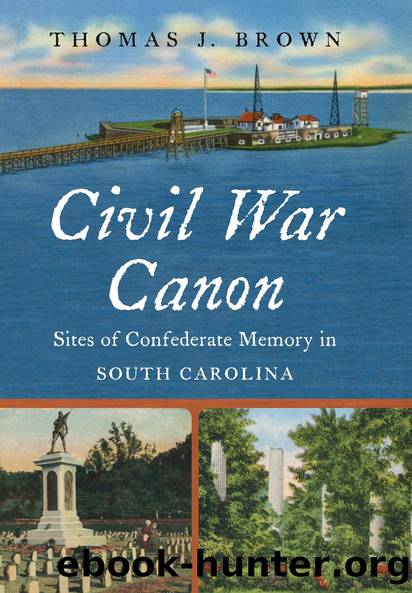Civil War Canon by Thomas J. Brown

Author:Thomas J. Brown [Brown, Thomas J.]
Language: eng
Format: epub
Tags: Nonfiction, History, Americas, United States, Civil War Period (1850-1877)
ISBN: 9781469620961
Publisher: The University of North Carolina Press
Published: 2015-02-17T05:00:00+00:00
Fort Sumter from the southwest, 1948. Courtesy of Fort Sumter National Monument, Charleston, S.C.
The centerpiece of the makeshift gallery was the storm flag that Anderson had flown during the bombardment and the larger garrison flag he had saluted at his surrender and raised on his return. In 1905, Andersonâs family presented the banners to the War Department, which displayed them in the secretary of warâs reception room alongside the Appomattox surrender table and other Civil War treasures. The New York Times protested in 1911 that very few visitors to Washington could see the Fort Sumter colors, âthe most famous relic next after the Constitution of the United States.â The flags remained in a similar display after the War Department moved to the Pentagon during World War II, but in 1954 the Defense Department transferred them to the National Park Service. Placed on public display at Fort Sumter National Monument, the banners powerfully supported a primary theme of the shrine. The staff advertised the acquisition by temporarily removing the tattered flags from their protective case for a photograph that appeared in National Geographic, the most widely circulated travel magazine of the 1950s.56
Fort Sumter National Monument figured prominently in federal planning for observance of the Civil War centennial. The National Park Service assigned the site priority funding under Mission 66, the ten-year plan to improve facilities by the agencyâs fiftieth anniversary in 1966. This support enabled the staff to expand dramatically on previous picking and shoveling by bringing in heavy equipment in 1959 to remove nineteen thousand cubic yards of rubble and fill. The excavation uncovered original brickwork and part of the parade ground and found sixteen more cannons. The mounted navigation beacon, for decades the most useful feature of the fort unrelated to tourism, was moved to another point in the harbor. Mission 66 funding also provided for construction of a permanent museum in Battery Huger, to be dedicated at the hundredth anniversary. Admissions trends rewarded the federal investments. The number of visitors brought to Fort Sumter by concessionaire Gray Line Tours nearly quintupled from 10,773 in 1950 to 51,800 in 1960. Meanwhile, the U.S. Civil War Centennial Commission (CWCC) began working on a pyrotechnic reenactment of the April 1861 bombardment immediately after the federal agency launched operations by hiring public relations entrepreneur Karl Betts as executive director in the spring of 1958. Betts predicted that âthe trek toward battle sites during the Centennial is expected to result in the greatest tourist movement in history.â57
Fort Sumter also loomed large in South Caroliniansâ planning for the anniversary of the Civil War, or as the state legislation establishing a coordinating agency styled the conflict, the âAmerican War between the Confederated States of America, South, and the Federal Union of the United States of America, North.â The well-practiced Charleston tourism industry looked forward to welcoming a flood of visitors. A three-day extravaganza organized by the Citadel for the anniversary of the repulse of the Star of the West was one of the most prominent events in the national kickoff of the CWCC campaign in early January 1961.
Download
This site does not store any files on its server. We only index and link to content provided by other sites. Please contact the content providers to delete copyright contents if any and email us, we'll remove relevant links or contents immediately.
| United States | Abolition |
| Campaigns & Battlefields | Confederacy |
| Naval Operations | Regimental Histories |
| Women |
In Cold Blood by Truman Capote(3348)
The Innovators: How a Group of Hackers, Geniuses, and Geeks Created the Digital Revolution by Walter Isaacson(3003)
Steve Jobs by Walter Isaacson(2861)
All the President's Men by Carl Bernstein & Bob Woodward(2347)
Lonely Planet New York City by Lonely Planet(2198)
And the Band Played On by Randy Shilts(2169)
The Room Where It Happened by John Bolton;(2135)
The Poisoner's Handbook by Deborah Blum(2112)
The Murder of Marilyn Monroe by Jay Margolis(2080)
The Innovators by Walter Isaacson(2076)
Lincoln by David Herbert Donald(1966)
A Colony in a Nation by Chris Hayes(1903)
Being George Washington by Beck Glenn(1783)
Under the Banner of Heaven: A Story of Violent Faith by Jon Krakauer(1766)
Amelia Earhart by Doris L. Rich(1670)
The Unsettlers by Mark Sundeen(1660)
Dirt by Bill Buford(1651)
Birdmen by Lawrence Goldstone(1641)
Zeitoun by Dave Eggers(1620)
